Suji ka halwa is your classic everyday delicious North Indian sweet made with fine semolina or cream of wheat (farina), sugar, ghee, nuts and flavored with cardamom powder. In Maharashtra, this sweet is called as Sheera. Semolina is called as suji, sooji or rava. This easy melt-in-the-mouth halwa recipe comes together in about 15 minutes. The recipe I share is a family heirloom recipe that we have been making for decades during family get-togethers, special occasions and festivals.
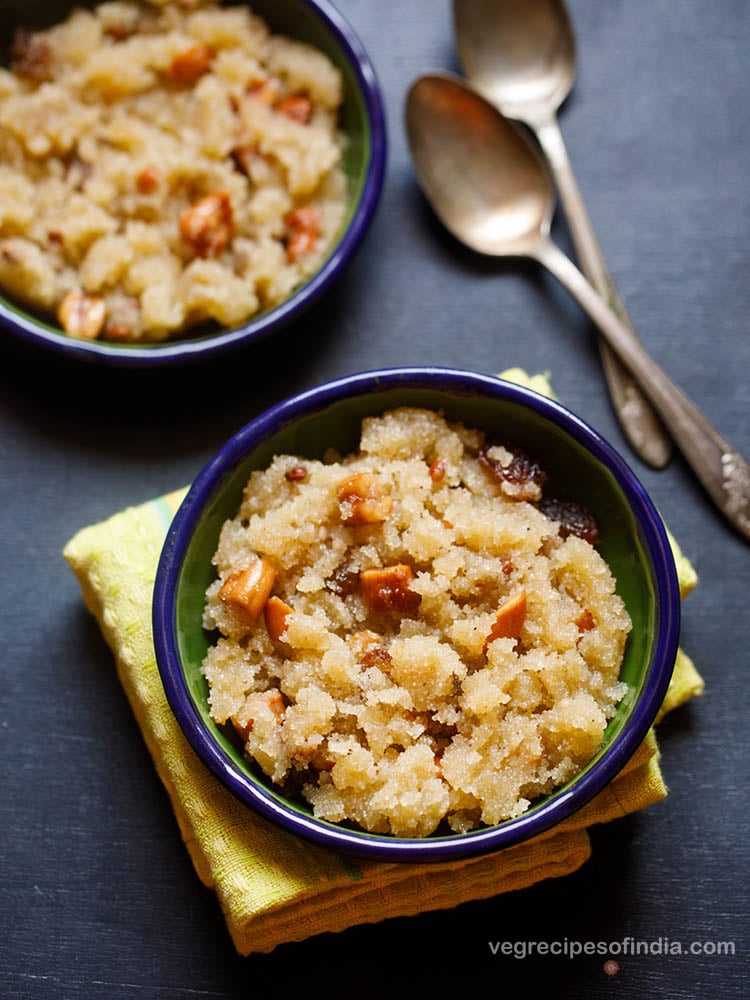
Suji ka Halwa and It’s Variations
Suji halwa is also known as Rava Sheera in Western India and Rava Kesari in South India. The method of preparation is more or less similar, with a few ingredients being changed here and there.
Though rava or semolina remains the key ingredient. In some variations, milk is added instead of water and is called as milk kesari. For flavorings usually, cardamom powder is added.
This halwa is also made for an auspicious occasion or a pooja ceremony. It could also be a festive occasion like Diwali, Ganesh Chaturthi or a religious ceremony conducted in your home or you just want to have something sweet. It also serves well as a sweet morning breakfast or an after-meal dessert.
Since this is an easy and quick halwa recipe, you don’t need any excuse or occasion to make it. I often make sooji halwa as a bhog or naivedyam to be offered to the deities.
We always make Suji halwa with puri during the Navami pooja of Navratri festival. Kala chana is also made. On this day we offer kala chana, suji halwa and puri to the small girls (kanjak) who symbolize the Mother Goddess.
The rava kesari that is popular in South India, usually has orange synthetic color added. But you can make the same, with natural coloring agents like saffron threads or saffron powder.
Saffron threads or kesar can also be added in sooji halwa like this Saffron Suji Halwa.
Along with this halwa recipe, I make other types of halwa recipes too. I don’t make them everyday, but when we have pooja or during festive occasions or sometimes just as a sweet snack.
I have shared many halwa varieties and you can check them here in this collection of 28 Halwa Recipes.
Sooji Halwa Proportions
Sooji halwa recipe is often made in bulk on festive or religious occasions. If you want to make a large quantity, then there is a certain proportion you have to follow.
The ratio of suji to sugar to water to ghee is 1:1:2:0.5 in a cup or glass measurement. I slightly deviate from this proportion and add a bit less ghee and sugar.
- Sugar – For 1 cup of sooji or rava, I add ⅔ or ¾ cup of sugar. So the suji halwa has less sweetness or is just sweet. 1 cup of sugar gives a very sweet taste.
- Ghee – I also add ⅔ cup ghee for 1 cup of suji. For me, ⅔ cup is a good amount of ghee. Reduce or increase the ghee if you prefer.
- Water – I add 2.5 cups water for 1 cup of suji. Though you can even add 2 cups of water. The amount of water can also be increased depending on the quality of the rava and if you want a pudding-like smooth consistency.
How to make Suji ka Halwa
Roast Suji or Rava
1. Heat ⅓ cup ghee in a kadai or a thick bottomed pan. Keep the heat to a low or medium-low. Use a heavy pan or else there is a risk of the suji getting burnt.
When the ghee is getting heated, at the same time keep sugar and water to boil in a pan on a different burner. Steps are mentioned below under the heading “Make Sugar Syrup“.
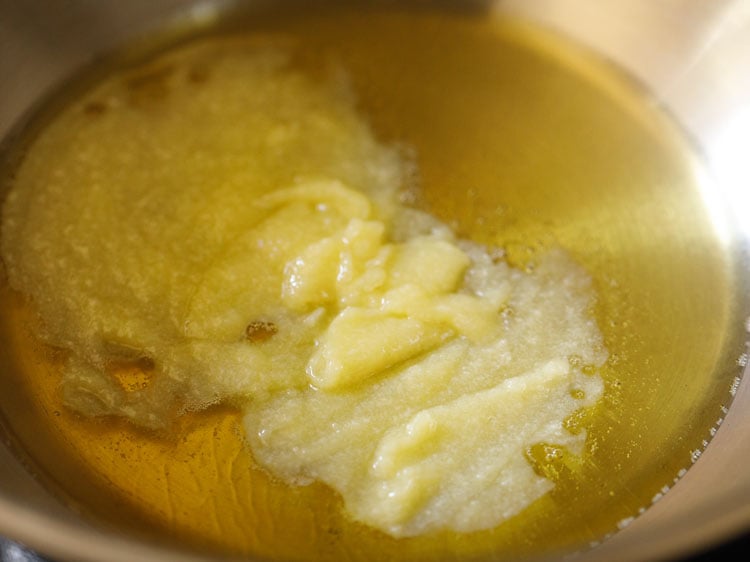
2. Add ½ cup sooji (rava or semolina). Use a fine variety of sooji and not the coarser variety.
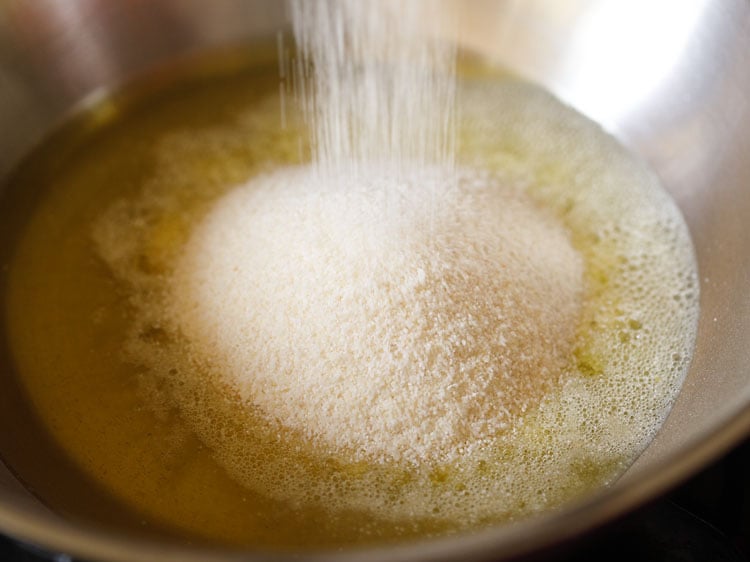
3. Also add 10 to 12 cashews halved or whole.
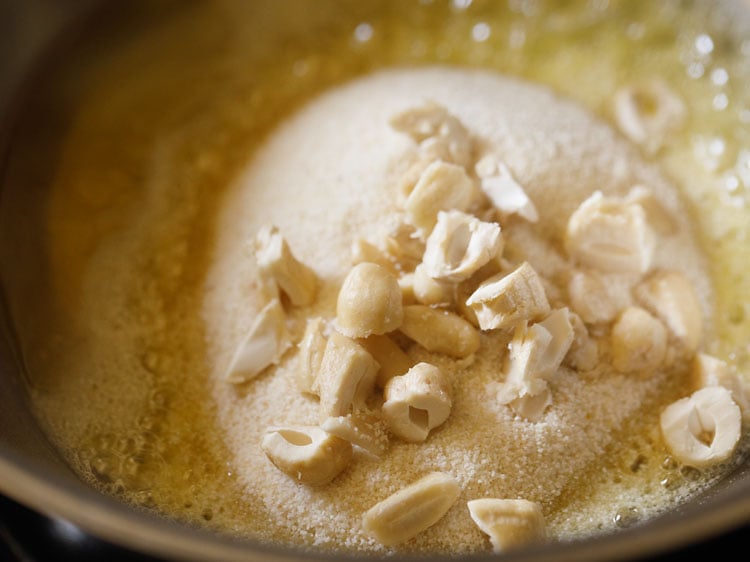
4. Mix very well and start roasting the sooji and cashews.
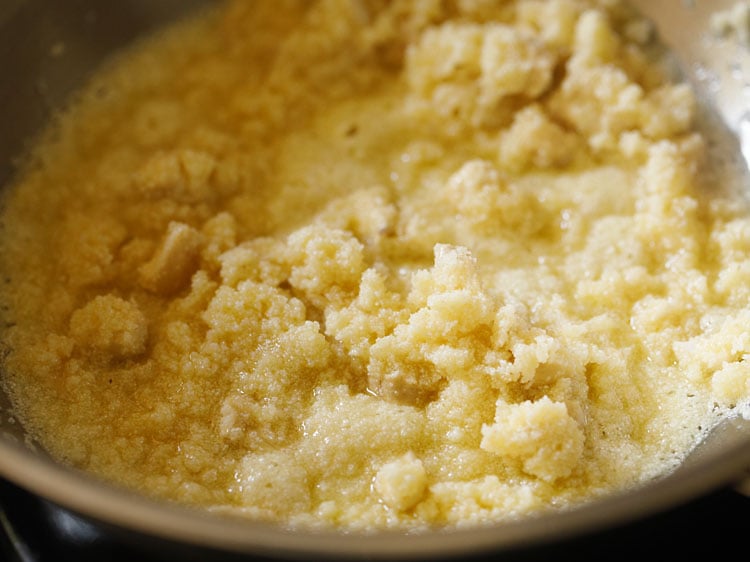
5. Keep on stirring the sooji so that the grains do not stick to the pan and are roasted evenly.
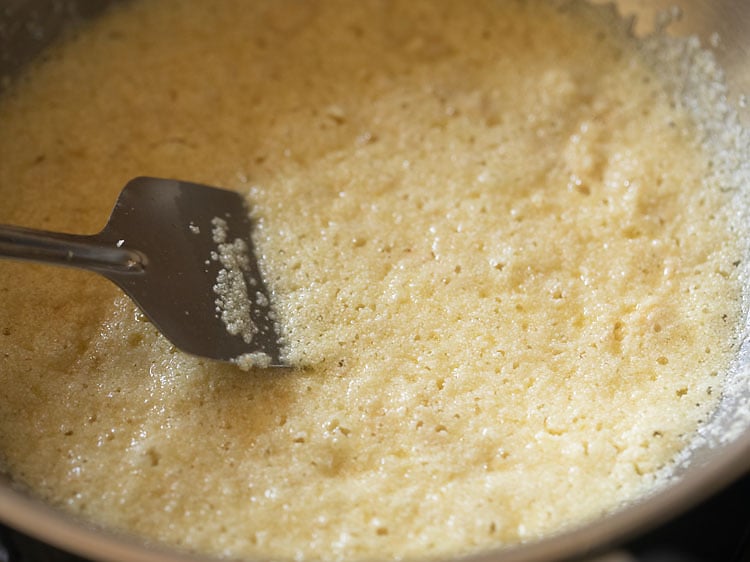
6. Roast sooji till you can see the ghee getting separated and when you see the cashews getting golden. The color of the suji or rava should not become brown. There will also be a fragrant aroma of suji and ghee in your kitchen.
Roasting suji takes approx 7 to 8 minutes on a low heat. This step is important because if sooji is not roasted well then you will not get the perfect texture in the halwa. There will be a slight raw taste in the halwa.
Handy tip – note that by the time the cashews get golden, the suji will also be roasted well. So keep on stirring and wait for the cashews to get golden.
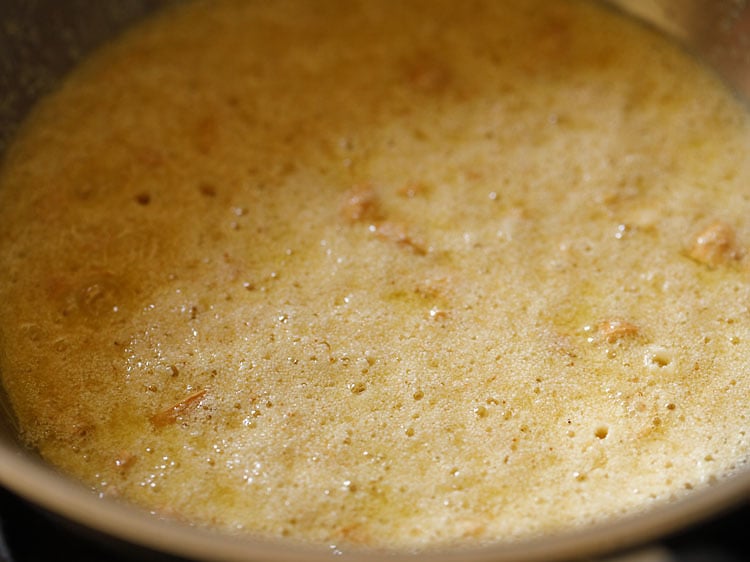
7. When the suji is roasted well, then add 1 teaspoon chironji (optional), 2 tablespoons golden raisins (kishmish) and a pinch of edible camphor (optional).
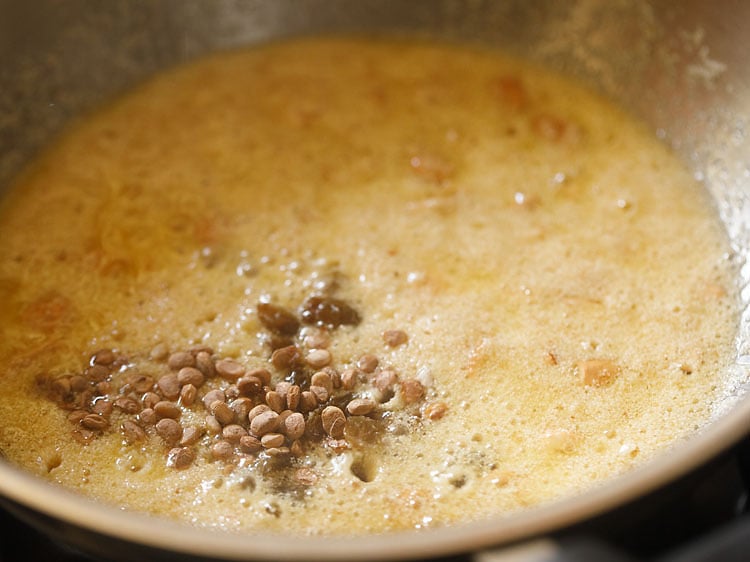
8. Next add ½ teaspoon cardamom powder (4 to 5 green cardamoms, powdered in a mortar-pestle, husks discarded). You can also add sliced almonds or pistachios.
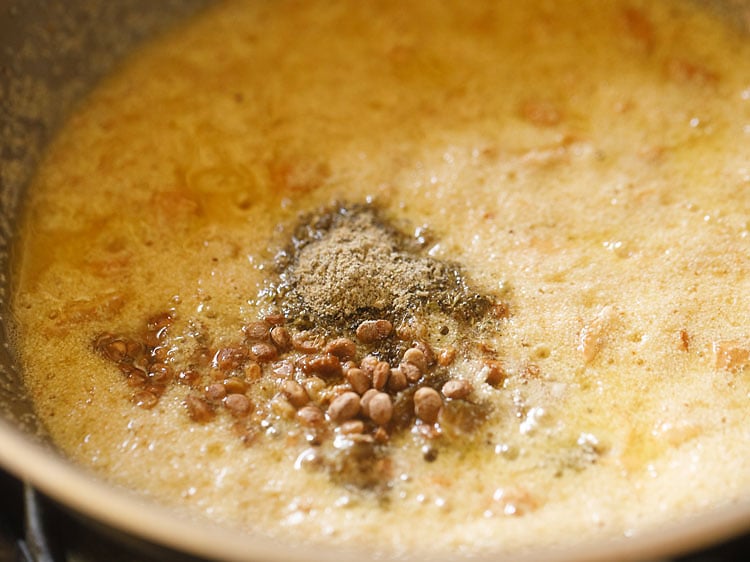
9. Mix well.
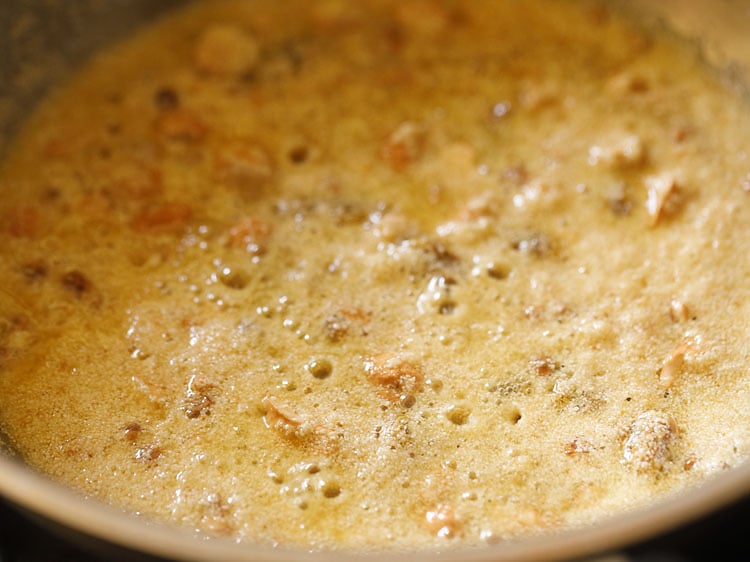
Make Sugar Syrup
10. When you keep the sooji for roasting in the ghee, at the same time, take ⅓ cup sugar in another pan or saucepan.
Here I have used raw sugar and hence the color of the water is not transparent but a light brown. I always use unrefined raw sugar in almost all of my cooking. Feel free to use white sugar in this halwa recipe. You can add the same amount of white sugar.
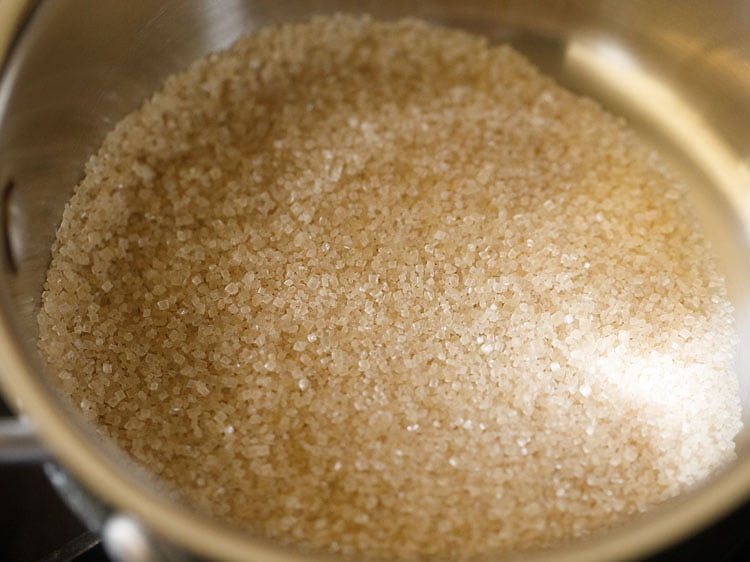
11. Pour 1.25 cups of water.
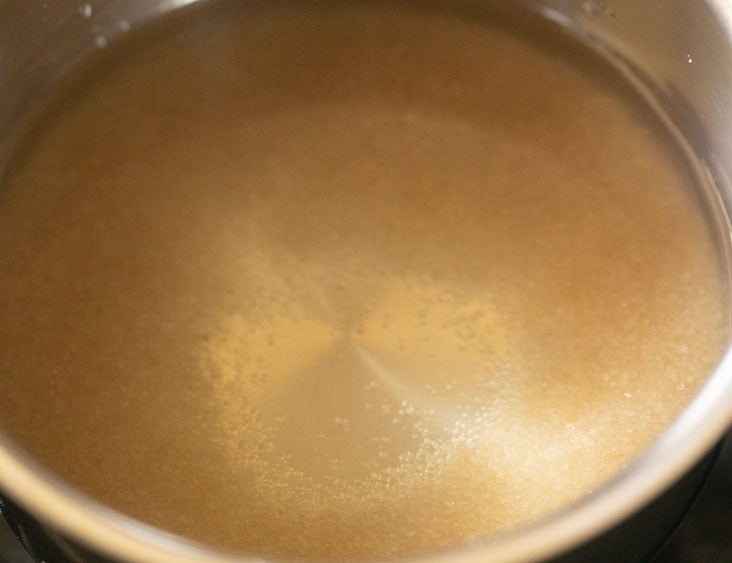
12. Keep the pan on a stovetop on medium-low to medium heat. With a spoon stir so that the sugar dissolves.
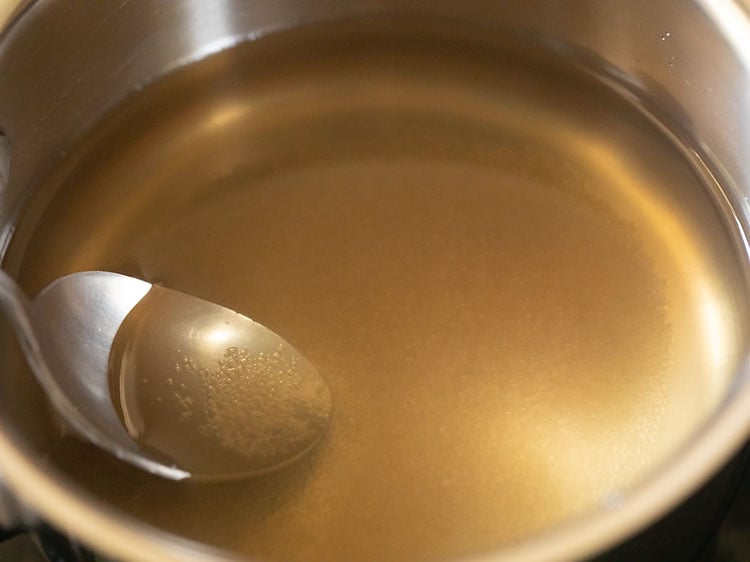
13. Bring the water+sugar solution to a boil.
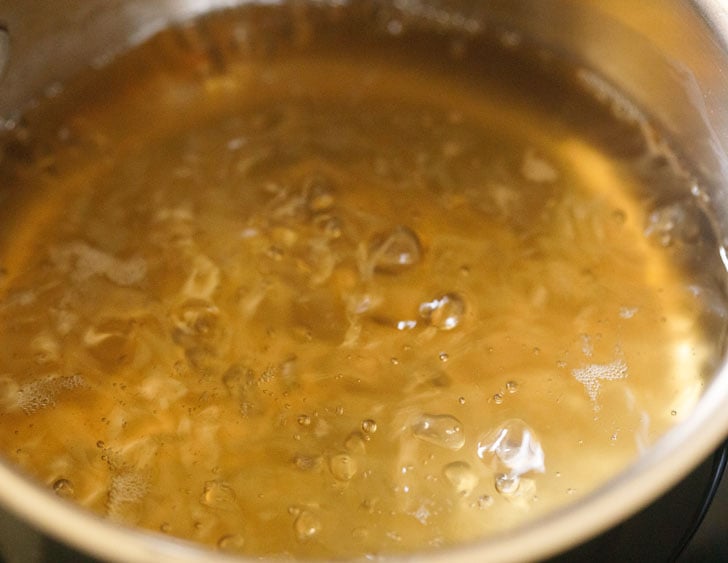
Make Halwa
14. Once you stir the raisins, cardamom powder and chironji, then pour the boiling and bubbling sugar syrup in the ghee & sooji mixture slowly, with continuous stirring.
Pour carefully, as the mixture sizzles and splutters.
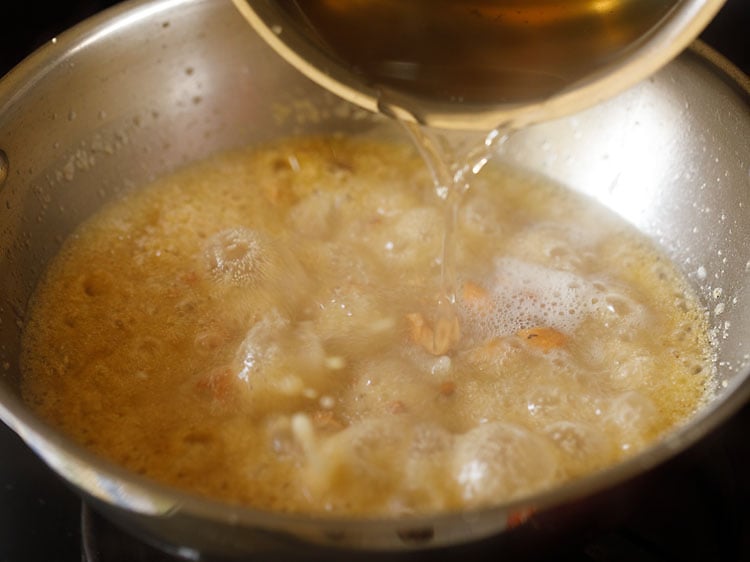
15. Mix very well so that lumps are not formed. Break the lumps if any with a spoon.
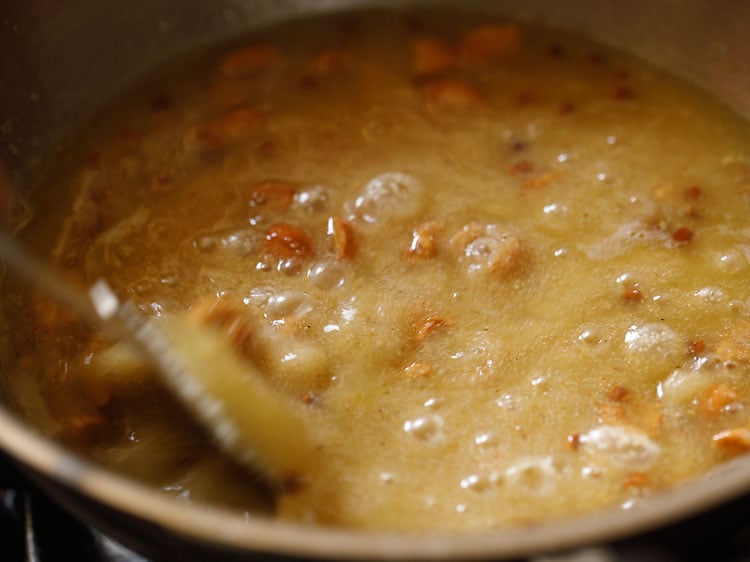
16. The sooji grains will begin to absorb the water and swell.
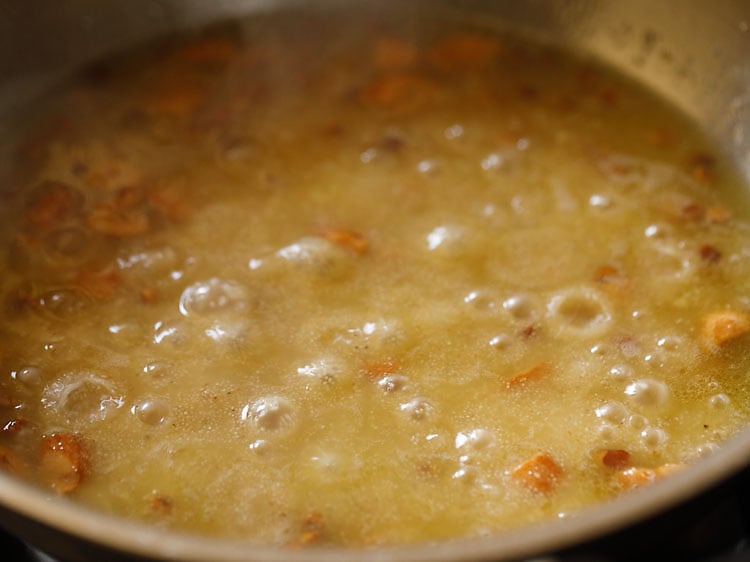
17. The mixture will start thickening. Keep on stirring often.
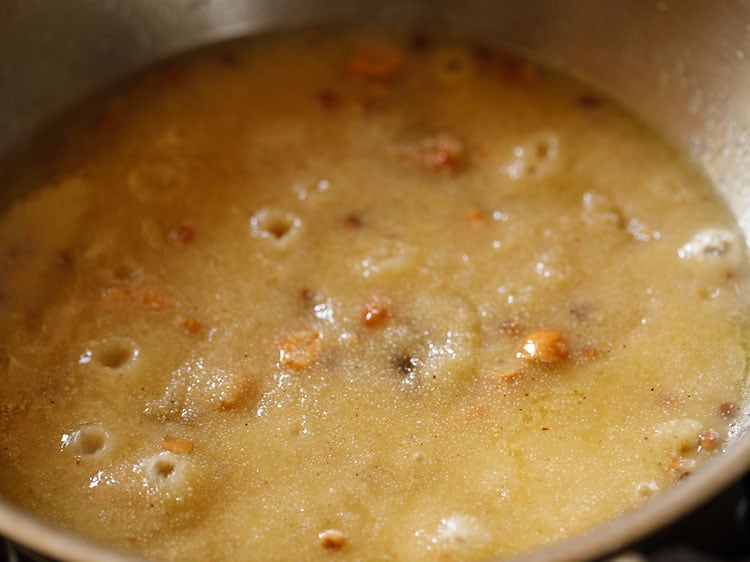
18. In the photo below, the halwa mixture has thickened but still soft, moist and the consistency is like that of pudding.
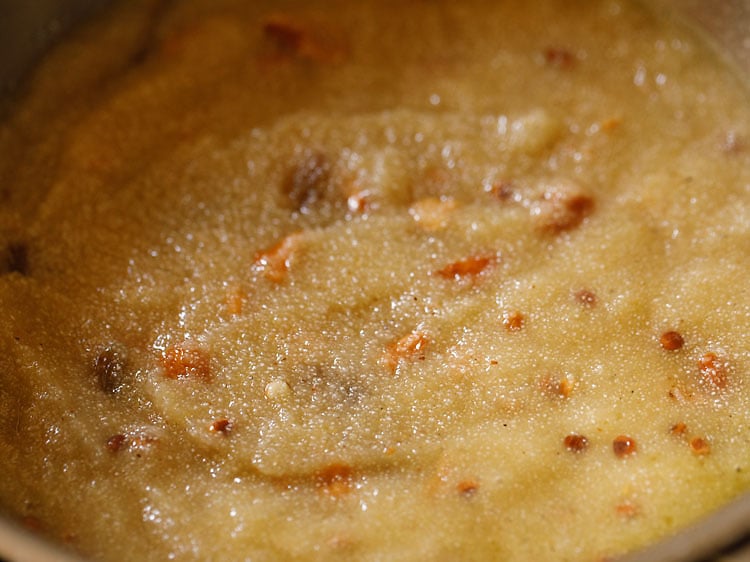
19. Once all the water is absorbed, you will notice the change in the texture. The ghee also will be visible at the sides.
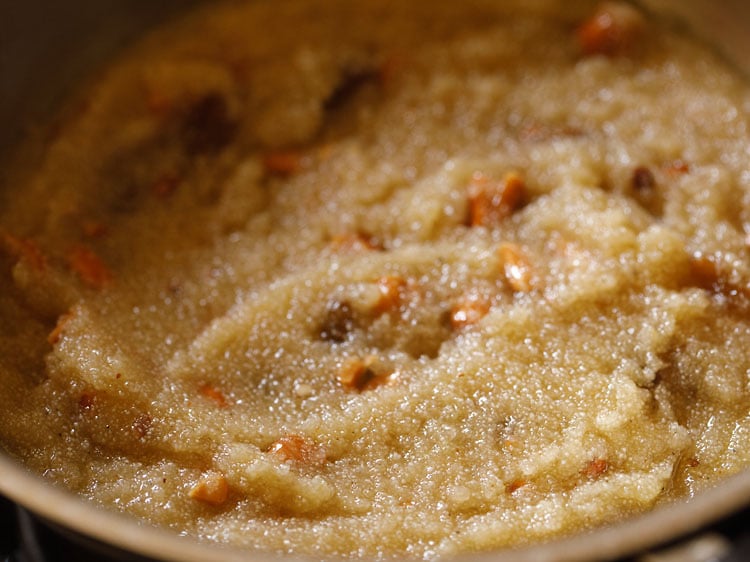
20. Keep stirring and cooking till you get the final texture of the rava sheera like the below picture. All the water should be absorbed and the halwa will leave the sides of the pan.
If you want to make slices or cubes or squares, then immediately pour the sooji halwa mixture in a greased pan or tray. Spread evenly and when warm or cooled, cut into diamond-shaped or square slices.
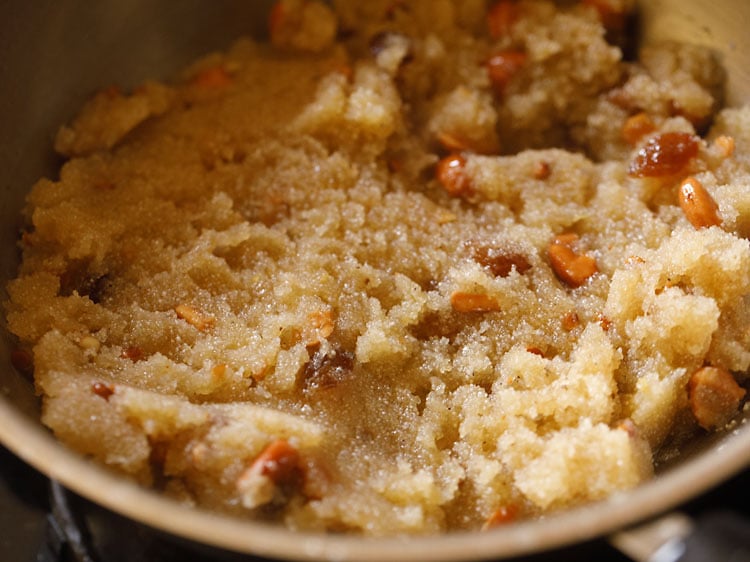
21. Serve suji ka halwa hot or warm or at the room temperature. Leftover suji halwa can be refrigerated. Before serving warm in a small pan or in a microwave.
Suji ka halwa or Sheera is usually served as a sweet snack. You can serve it after a meal. It can be paired with poori too or served as a dessert.
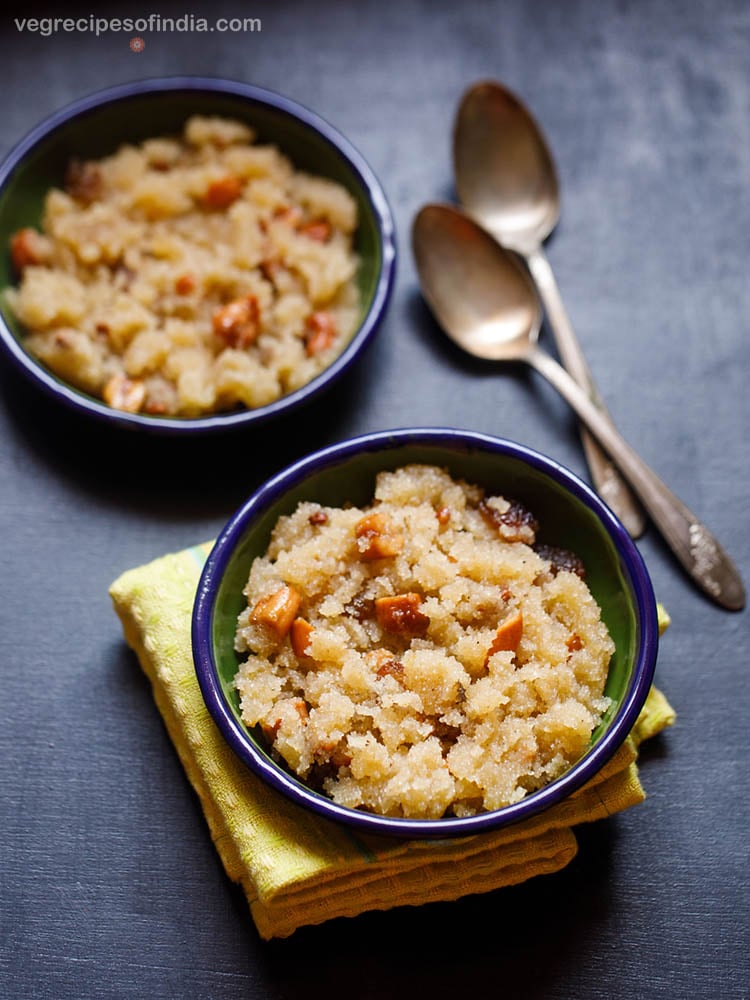
Expert Tips
- Type of suji or rava: Use the fine variety of suji for making halwa as it gives a smooth tasting halwa. You can also use Bombay rava. Ensure that your sooji is fresh and does not have any insects or molds. The sooji should be in the shelf period.
- Temperature: When adding the sugar solution to the rava, it has to be boiling and bubbling hot. If the sugar solution becomes warm, then heat it up till it comes to a boil. The roasted rava mixture also has to be hot when the sugar solution is added.
- Multi-cooking: When you begin roasting the rava, at the same time, keep the sugar solution to boil on another burner.
- Reducing Ingredients: You can reduce both the amount of sugar and ghee according to your taste preferences and health conditions.
- Sweeteners: Jaggery can be also added instead of sugar. First, add jaggery in water and heat the water till it becomes warm. When all the jaggery is dissolved, strain the solution to get rid of impurities. Put the strained solution back in the pan and heat till it comes to a boil.
- Liquids: Milk can be added instead of water and this will give the suji ka halwa rich taste and flavor.
- Flavorings: For flavoring and aroma, usually, cardamom powder is added. Variations can be 8 to 10 saffron strands soaked in some warm water or even rose water can be added.
- Dry Fruits and Nuts: You can add your choice of dry fruits and nuts. I usually add a mix of cashews, almonds, chironji and golden raisins. Sometimes I also add pistachios.
- Edible Camphor: Adding edible camphor is optional. If you are making sooji halwa for religious occasions then you can add a pinch of edible camphor. During 8th or 9th day of Navratri festival, this sooji halwa is made along with dry kala chana and pooris for kanjak pooja in parts of North India.
More Halwa Recipes!
Sweets Recipes
Halwa
Please be sure to rate the recipe in the recipe card or leave a comment below if you have made it. For more vegetarian inspirations, Sign Up for my emails or follow me on Instagram, Youtube, Facebook, Pinterest or Twitter.

Suji ka Halwa Recipe (Sheera Recipe)
Ingredients
- ½ cup suji (fine rava or semolina or cream of wheat)
- ⅓ cup sugar or approximate 5 to 6 tablespoons sugar or add as required
- ⅓ cup Ghee – approximate 6 tablespoons of ghee
- ½ teaspoon cardamom powder – or 4 to 5 green cardamoms powdered in a mortar-pestle, husks discarded (choti elaichi powder)
- 10 to 12 cashews – halved or whole (kaju)
- 2 tablespoons golden raisins (kishmish)
- 1 teaspoon chironji – optional (charoli)
- 1.25 cups water – can also add 1 cup water
- 1 pinch edible camphor (optional)
Instructions
Preparation
- Crush the green cardamom seeds to a fine powder in a mortar-pestle and keep aside. Remove the husks
- Keep a kadai or pan on a low flame.
- Add the ghee and when the ghee is heating up, do the following.
- Take the sugar and water in another pan.
- Keep this pan on a medium to high heat and let the sugar solution come to a boil.
- Once the ghee becomes hot, add the suji (semolina) and cashews and stir.
- Keep on stirring the suji (semolina) so that the grains does not stick to the pan and are roasted evenly.
- Meanwhile keep your attention on the sugar syrup also.
- If the mixture starts to boil, then lower the heat and let it simmer.
- Keep on roasting and stirring the semolina for 7 to 8 minutes till the grains change their color and when the cashews also change to a light golden or golden.
- You have to roast sooji till you can see the ghee getting separated. The color of the suji or rava should not become brown. There will also be a fragrant aroma of suji and ghee in your kitchen.
- Remember that the roasting rava is very important. If the rava not is not roasted well then you won't get the best texture in the halwa and there will be slightly raw taste.
- Then add the cardamom powder, chironji, raisins and edible camphor (optional). Mix very well.
Making suji ka halwa or sheera
- Stir and then add the bubbling hot sugar syrup slowly to the roasted suji mixture.
- Be careful as the mixture has the tendency to splutter.
- Be quick enough to stir. The sooji will begin to absorb the water and swell.
- Keep on stirring often till the whole mixture starts thickening and starts to leave the edges of the kadai or pan.
- Serve sooji halwa hot or warm or when cooled at room temperature.
- It can be had as a sweet snack or served as a dessert after meals.
- Store any leftovers in the fridge in an air tight container for 1 to 2 days. Reheat in a pan for while serving.
Video
Notes
- Type of suji: Use the fine variety of suji for making halwa. Ensure that your rava is fresh, within its shelf period and does not have insects or mold and is not rancid.
- Scaling: Recipe can be halved or doubled or tripled.
- Edible camphor: Add a pinch of edible camphor if you are making suji halwa for religious occasions.
- Temperature: When adding the sugar solution to the rava, it has to be boiling and bubbling hot. If the sugar solution becomes warm, then heat it up till it comes to a boil. The roasted rava mixture also has to be hot when the sugar solution is added.
- Multi-cooking: When you begin roasting the rava, at the same time, keep the sugar solution to boil on another burner.
- Adding less amounts: You can reduce both the amount of sugar and ghee. For less sweet taste in rava sheera, add ¼ cup sugar.
- Sweetener: Jaggery can be also added instead of sugar. First, add jaggery in water and heat the water till it becomes warm. When all the jaggery is dissolved, strain the solution to get rid of impurities. Put the strained solution back in the pan and heat till it comes to a boil.
- Liquids: You can add milk instead of water.
- Flavorings & Nuts: You can add your choice of dry fruits and nuts. For flavoring and aroma apart from cardamom powder you can also add saffron strands or even rose water.
Nutrition Info (Approximate Values)
This Suji Halwa recipe from the blog archives was first published in July 2014. It has been updated and republished on July 2021.
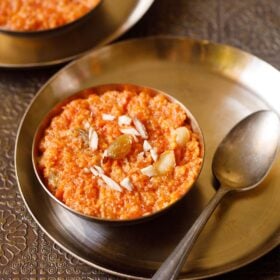
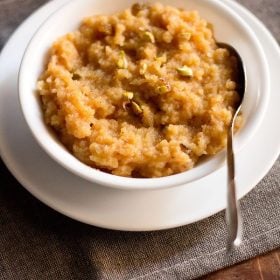
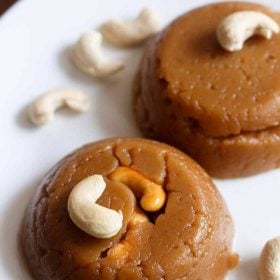
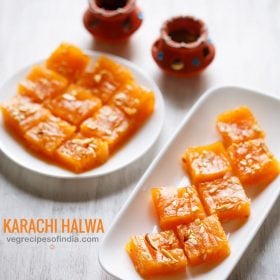








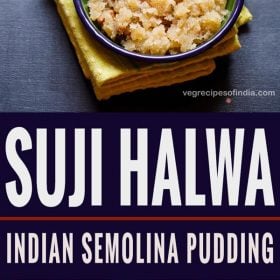
I’ve been following this recipe for years! Works wonders everytime. Thank you Dassana, for teaching me how to cook!
Great and thanks for letting me know. Also thanks for your lovely comment.
One of the few types of halwa I’ve made, this one reminds me of my childhood when all the kids were eating semolina for breakfast. Many hate it since then, but I love it!
Finally I achieved success in making the kind of suji halwa I like. Thank you so much for sharing the recipe!
Welcome and thanks for sharing this lovely feedback.
I am yet to make a recipe from your website that doesn’t taste delicious! Thank you.
Thanks a lot Eva for the lovely comment.
Very good recipe
Thank you.
Turned out really good thanks for those all side note
Which made me understand consistency of water ghee and sugar!
Love this!
Thank you!❤️
Thanks and glad that the tips helped. Thanks for the rating too. Welcome.
Perfect recipe for sooji halwa made it and turned out excellent
thanks mini for the feedback. happy cooking.
My family loved the halwa. Its easy to make and tastes really good. Now we make it often as a sweet snack.
Another wonderful recipe … The halwa turned out perfect 🙂
thanks deepti for sharing this awesome feedback and for the rating as well.
I love ur site. I. Never cooked in life n ur site explains everything for begginer. Thank u so much Dassana
thanks dr samita. glad to read your comment. most welcome and happy cooking.
Hi Dassana
Vegrecipes is always my go to place when in doubt or looking for inspiration to make vegetarian dishes. Your array of recipes is outstanding.
Made the sooji halwa, followed your recipe to the T, except substituted jaggery for sugar and it turned out yummy and healthy!
thanks a lot sanjyot. glad to read your feedback on sooji halwa as well as your positive views on the recipes. jaggery is definitely a healthier substitute. happy cooking.
Absolutely delicious ! And quickly made… I am French and living in India… I wanted to buy some semolina for couscous but ended up with Sooji semolina… so I looked on the web what could be done with it… and that is why I have tried your recipe ! I will do it again for sure…
thanks laetitia. there are many indian recipes you can make with sooji semolina.
Super! Made this per recipe without the chironji n camphor: turned out excellent! Just like the prasaad served at temples and gurdwaras .
Thanks Sheetal for your positive feedback on Halwa Recipe.
Thank you dassana for such a scrumptious recipe!
Really turned out very well.. as do all your recipes!
Thanks heaps for sharing such accurate recipes with precise details, love your accompanying pictures too.
Lots of love and gratitude????
P. S. : I prepared this as naivedya for dasara and it tasted awesome!
thank you natasha for this lovely comment and the feedback on sooji halwa. wish you a happy dassara festival. happy cooking ????
wow great blog and recipes 🙂
thanks kumkum
I love ur website….I am a keralaite…sooji halwa is actually not our recipe. …but I always loved to have it……as my hubby enjoys it a lot I made it…. it came out very interestingly….yummy…my two year old girl have it as well…..thank u
Welcome SHERIN. Glad to know that everyone liked the sooji halwa recipe.
Your techniques and style if cooking really work for me. Thanks for the lovely recipe.
Welcome Rithika. Nice to know this.
Thanks for ur explanations…I would like to know the protein content…is it good for a kidney disease patients to eat sooji?
sooji is made from wheat grains. so the protein content is less, but is good in carbs. so you can include it your food. but do take advise from your doctor or health practitioner as to the food ingredients that you can safely include in your meals.
Dassana….I want to try…three layer bottom of biscuits n butter mixed….middle your sooji halwa…on top yr chocolate sauce…pl guide me as to how to make base using biscuit n butter…
shubha, for butter and biscuits layer, you can check the method in the links mentioned below. but in these links, the biscuits is ground and then made in a layer. you can of course make a thick layer. use any good quality crackers or marie biscuits. you can increase the proportions accordingly. btw your recipe is very innovative and i am sure will taste good too.
mango cheesecake – https://www.vegrecipesofindia.com/eggless-mango-cheesecake-recipe/
eggless cheesecake recipe – https://www.vegrecipesofindia.com/eggless-cheesecake-recipe/
Thank you dassana for the link… Got idea from I live cooking show of living foods..maria did boiled oranges with sooji…I just thought of skipping oranges…I m entirely dependent on your measurements… I know ur sooji halwa n choclate sauce…One more doubt dear…. Can v use good day biscuits..or y only Marie..curious to know
thanks shubha. marie is one biscuit you can use easily for a base. i told the name as its easily available. generally graham crackers are used, but they are not available everywhere, especially india. so i use cream cracker or marie biscuits. you can even use multigrain biscuits or crackers. even glucose biscuits can be used. and yes you can use good day biscuits.
Thank you for this recipe you are great cook. I have a question, my sheera tends to become sticky or hard as opposed to my mother’s, what am I doing wrong?
tejaswi, add more water and roast or fry rava very well. ghee should release from the sides once the rava is done roasting. the proportion for a melt in the mouth smooth sheera would be 1:2 or 1:2.25 for rava and water respectively. you can even use 1:3. this gives a really smooth sheera much like the south indian kesari.
Thank you so much for this beautiful recipe. I did not have any ghee, raisins or cashews but really wanted to make some halwa, so I went ahead with the recipe (used butter) and it turned out so well! I’m Bengali and am not even supposed to like halwa (just kidding). Next time, I’m going to try Stevia instead of sugar. Thanks again!
Welcome Jaux. Nice to know that you liked the halwa. Do try some more recipes.
Hello amitji thanks for the recipe wonderful,but my father always roast the Suji in a karaii till lightly brown,and aroma rises.his ancestors are from Andhra Pradesh. Don’t know why? But taste good also.
Welcome Roodravany. Rava can be dry roasted also or can be roasted in ghee also. Both ways the sooji halwa taste good.
Can we use milk in halwa ?
yes you can use milk.
Can we add haldi for the yellow colour instead of kesar..?
yes. just add generous pinch of haldi.
Followed the recipe as given except used less ghee but still it turned out to perfection really really tasty. Thanks
thank you lalita for this feedback. good to know 🙂
Excellent Recipe! Do you have any mobile app that can be downloaded?
yes hd we do have our app which could be downloaded from google play store for free. hope this help’s you.
Hello mam can I try to fry sooji in butter instead of ghee
Thank you
uzma traditionally sooji halwa is made in ghee and would taste the best if made in ghee and not butter. hope this help’s you.
Made it…turned out perfect…i ws jst wondering how lucky ur family members are who get to taste ur awesome delicacies… Ur awesome way of preparing dishes is jst unmatchable…have tried so many recipes and none failed and m damn sure none of ur recipes will ever fail…thank u so much…
pleased we could match your expectations thankyou for your positive words 🙂 you are welcome always.
You are an amazing cook… I have tried many of your recipes and they have turned out absolutely delicious and finger lickingly tasteful… Thanks a lot!!! Keep up the great work
thanks a lot anindita.
How can this be made with Jaggery instead of Sugar?
for making with jaggery, heat jaggery and water together till the mixture comes to a boil. if the jaggery has impurities, the first heat gently till all the jaggery melts. filter this solution and keep on flame again, till the solution comes to a boil.
Thanks for your wonderful recipes…I wanted to ask whether halwa taste better in water or milk or in combined of both….please help.thank you.
personally we prefer halwa made in water. milk gives a rich taste and some people prefer milk based halwa. you can also go the half-half way.
This is exactly how my mom used to make Rawa kesari (South Indian term for sooji halwa).Took me back to those wonderful, simple and happy childhood days. I am going to make this for a festival event on this saturday. Thank you for posting this recipe!
pleased to know shravani that sooji halwa made you nostalgic about good memories 🙂 thankyou and you are welcome.
Thank you so much for your great recipes ..I m really grateful to you for ur every recipe …it has helped me to learn cooking with perfection …thanks for ur detail explanation with pictures..
welcome jayshree. thanks for your kind words and positive feedback.
i am very impress of this site,i know many recipes, i thing it’s best site in the world. In this site people learn too many recipes. Any person who loved cooking this side is best for that.
thanks nazir for your kind words and positive feedback.
Is it necessary to boil the water and sugar separately.
what will happen if we add sugar in fried sooji and then add water.
sushant, if you want to add sugar separately then add sugar once you add the hot water.
I am learning to cook and this is the first recipe I made on my own. Thank you so much for explaining everything in so much detail. Everyone in the family loved it 🙂
welcome ashwini. glad to know this.
Can I use milk in the above recipe???? The halwa is extremely tasty… Thank you so much…
welcome ankita. yes you can use.
Really nice.
thanks riya
Very good recipe. What is ‘Chironji’ ?
thanks rom. chironji is small flavored seeds usually added in sweets. they are also as charoli in marathi.
Hi, I’d like to try and make this as a gift for my grandma. How long can we store the halwa?
stays good for about two days in the fridge.
The way the receipes are prepared are simple and easy to understand thank u very much
welcome.
Thanks dassana …it is very simple and also quick
welcome kshirod
is the halwa supposed to be hard?
no. its soft.
Awesome recipe…. I like all your recipes. I m learning how to cook. and I think the easiest recipes are here in veg recipes of India. thanks a lot for posting this recipe..
thanks a lot zil.
We can add sugar later if we come to know that its tasteless
Can i use milk instead of water in Sooji Halwa
nital, you have to heat the milk with sugar and then use it instead of water.
very simple and nice
thank u so much
i m going to try this ..
welcome sneha
Hi Dassana,
Thank u very much for posting this recipe,nice color
welcome sujata
Is this halwa is different with rawa kesari?
the preparation is same, just that it different in the flavors. here i have only added cardamom, but in rava kesari, i add saffron. you can add both. rava kesari has a yellow or orangish color as food colors are added. i prefer to use saffron as a natural coloring agent. though even turmeric (just a pinch) can also be added to give the yellow color. i usually keep the same proportion of sooji/rava, sugar and ghee for both rava kesari and sooji halwa. but mostly rava kesari has more ghee added to it. rava kesari can also be made with milk instead of water and so is sooji halwa.
i like it very much. the method of explanation is very simple.
thanks waseem
Hi dassana,
this is my son’s all time favorite… the color of the halwa is mouth watering …golden… the presentation is so lovable..the light effects so soothing.. i will follow this halwa now onwards instead of what i was making till now… your recipes are just matchless… sooji halwa is an old recipe but you make it like its a delicacy…hats off…keep going
thanks monika. glad to know that you liked the halwa color.
Yummy and perfect sooji halwa
thanks ramya